
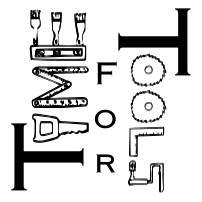



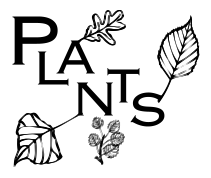
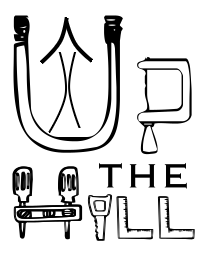



| Next Post - Previous Post List View
| |
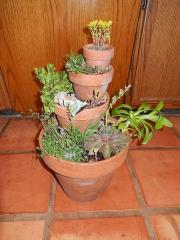 | 6/26/2014 7:52:53 PM Class it Up... Stacked Clay Pots |
After my friend got me looking into Gnome gardens, I found a lot of cool pictures online for miniature gardens and broken-pot gardens. While I have enough spare clay pots to make a broken garden, I decided that these with a few chips and cracks are just as good as a "stacked garden" and quicker to put together than a carefully planned broken-pot garden. While nice planters in the stores can cost a small fortune, since this could easily use old pots that you or friends have laying around, this could be a very budget-friendly way to put together a very nice planter. Also, by using some of the small native plants, the costs can be kept very reasonable for a great plant feature.
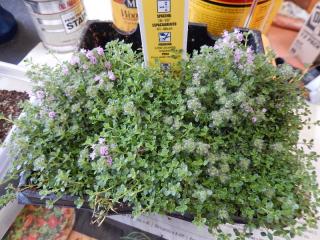 The important part for a successful long-term garden is finding plants that stay relatively small like this "elfen thyme", or you would end up trimming or replacing the plants frequently. I also wanted plants that don't need a lot of water since I already have a lot of wicked plants that like a lot of water and while I could wick the lower pot, I doubt it would be as easy to run wicks to the upper pots. Besides, sometimes it is just nice to have a few plants that don't mind a drought now and then. The important part for a successful long-term garden is finding plants that stay relatively small like this "elfen thyme", or you would end up trimming or replacing the plants frequently. I also wanted plants that don't need a lot of water since I already have a lot of wicked plants that like a lot of water and while I could wick the lower pot, I doubt it would be as easy to run wicks to the upper pots. Besides, sometimes it is just nice to have a few plants that don't mind a drought now and then.After deciding that I did not want to wick the plants since these would be low water varieties, I thought that it still would not hurt to allow the lower pot a little reserve of water that would provide a little evaporated water to the pot over time. It also reduces the amount of soil in the pot and should help keep the tiny plants from getting overly excited and out-grow their area. 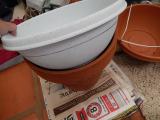 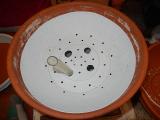 I used the bottom of a bleach bottle for the water reservoir and then used a cut down hanging planter with holes drilled in it above that to hold the dirt and gravel. I also added a vinyl pipe so that I can pour water right into the reservoir and when it over-flows a little and runs out of the bottom of the pot, I will know it is full. I used the bottom of a bleach bottle for the water reservoir and then used a cut down hanging planter with holes drilled in it above that to hold the dirt and gravel. I also added a vinyl pipe so that I can pour water right into the reservoir and when it over-flows a little and runs out of the bottom of the pot, I will know it is full.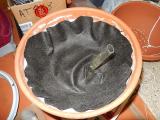 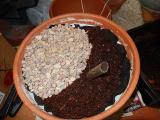 Then I added a layer of landscape fabric. It will keep dirt from falling through into the reservoir. I filled the upper pot with an area of gravel (to aid draining from the next pot) and the rest with soil for planting. I added gravel and planting areas to the upper pots as well, and then placed them on the gravel portion of the pot below. Then I added a layer of landscape fabric. It will keep dirt from falling through into the reservoir. I filled the upper pot with an area of gravel (to aid draining from the next pot) and the rest with soil for planting. I added gravel and planting areas to the upper pots as well, and then placed them on the gravel portion of the pot below.Not bad at all for some spare clay pots. Despite my penchant for the ancient-oriental look that I try my best to impart to much of the house, I am not usually a fan of the more "southwestern" rustic style. This definitely brushes that category, but doesn't seem too far. I think the effect is probably based almost solely on the plant choices since it could easily be very southwest with cactus involved, or almost tropical if you chose more soft greenery. About half the plants are ones that hubby got from the store for me or someone gave me, and about half are some of the native tiny plants that grow in the aspen area between our driveways. Click the picture to see it larger:
While I am not 100% sure that all the natives will be happy year-round indoors, I think it is a good start to an easily maintainable "stacked" garden, and I am pretty happy with the balance of plants. They all have low water requirements, but since they are all under stress from transplant, I have been watering them with a squirt bottle every couple days. I will continue to do so for a while, then go to watering about once a week... less or more often depending on how the plants feel about it.
| |
Next Post - Previous Post List View | |
Add Your Comment...


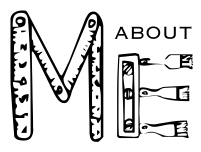


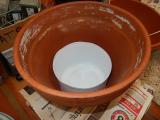

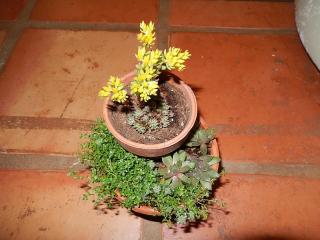
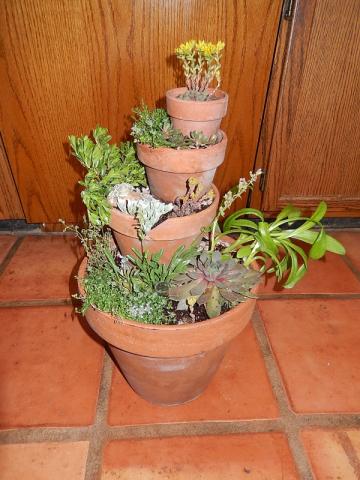
Absolutely perfect. You need to make a dozen and sell them at your local farmers market. You could make a bundle to spend on your bigger projects like concrete for steps one one.
You are just amazing!!